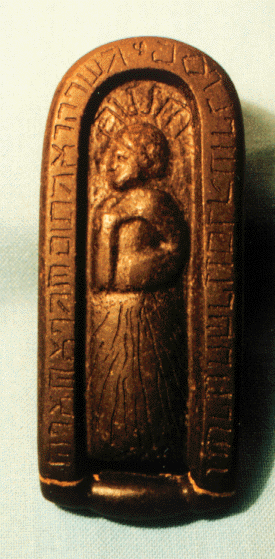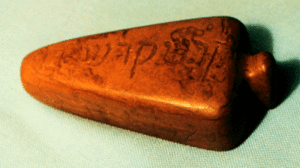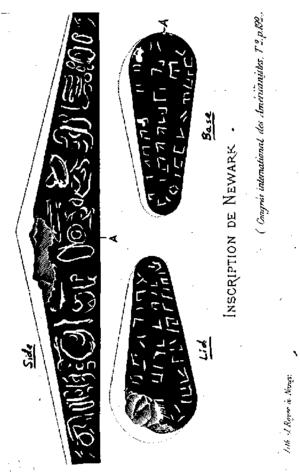Newark Holy Stones facts for kids
The Newark Holy Stones are a group of old objects that people claimed were found in 1860. They were supposedly discovered by David Wyrick in ancient Native American burial mounds near Newark, Ohio. Today, most people believe these stones are a hoax, meaning they were faked.
The set includes a stone called the Keystone, a stone bowl, and another stone called the Decalogue, which came with its own sandstone box. You can see these objects at the Johnson-Humrickhouse Museum in Coshocton, Ohio. The place where they were found is called Newark Earthworks. This is a huge collection of ancient structures built by the Hopewell culture, a Native American group that lived from about 100 BC to AD 500.
The Johnson-Humrickhouse Museum used to show these artifacts without saying if they were real or fake. However, they changed their display after museums started talking about the importance of "Trust, Truth, and Fake News." Museum leaders realized that museums are never truly "neutral." The museum's director explained that being neutral about the Holy Stones would have consequences. They felt it was wrong to be neutral because the stones show us more about Ohio in 1860 than about 100 AD. They also highlight how some people tried to take away Native Americans' history. The new display lets visitors see the stones from all sides. It also has an iPad with close-up photos and information about the stones' discovery. This helps visitors understand how the stones connect to changes in the United States during the late 1800s.
Contents
Discovering the Stones
The first object found was the Keystone in June 1860. It got its name because of its unique shape. What made it different from other ancient objects found nearby was that it had Hebrew writing on it. Each side of the Keystone has a short phrase:
- Holy of Holies
- King of the Earth
- The Law of God
- The Word of God
The second important find happened later in November 1860. Wyrick and his team found a sandstone box. Inside this box was a small, black rock. Geologists from Denison University identified the black rock as limestone. This stone had Hebrew text carved into it. This text was translated as a shorter version of the Ten Commandments. Because of this, the stone is called the Decalogue Stone. The word "Decalogue" refers to the Ten Commandments, which are religious and moral rules found in the Bible (in Exodus 20:2-17 and Deuteronomy 5:6-21).
The writing on the Decalogue Stone starts at the top of an arch on the front. Below the arch is a figure of a bearded man wearing a turban and a robe, holding a tablet. The writing goes down the left side, wraps around all sides of the stone, and then comes back up the right side to where it began. This pattern suggests the inscription was meant to be read over and over. Right above the man's figure, there is a separate inscription that translates to "Moses". The Hebrew writing on this stone looked very old. However, it was later shown to be based on the modern Hebrew alphabet, not ancient Hebrew.
Dating the Wooden Platform
In 2014, a researcher named Bradley Lepper found a piece of the wooden platform. This platform was buried under the Decalogue Stone. The wood had been saved at Yale's Peabody Museum of Natural History. Scientists used radiocarbon dating on this wood. This method helps find out how old something is by measuring carbon.
The dating showed the wood was from between AD 85 and AD 135. The platform was made from a large oak tree. So, the actual burial could have happened a few decades after the tree grew. These dates fit with the time of the Hopewell culture. This was the Native American group that built the mound where the stone was found.
Why They Might Be Fake
The Newark Holy Stones are often seen as an archaeological fraud. This means they were faked to support a certain idea. This idea was the "Lost Tribes" theory. It claimed that ancient Israelites lived in Ohio before Christopher Columbus. The belief that ancient Hopewell mound builders were connected to Jewish settlers in America is a type of pseudoarchaeology. Pseudoarchaeology is like fake archaeology; it uses unproven ideas instead of scientific facts.
The first stone found, the Keystone, was written in modern Hebrew. In July 1860, a scholar named Abraham Geiger wrote in the New York Times. He said the writing was "bungling work" with many mistakes. He also said the letters were not ancient. He believed it was not a real old artifact.
Just over three months later, the second stone, the Decalogue, was found. This one was much more detailed and written in older-looking Hebrew. One expert, Ken Feder, compared this to someone finding a fake Shakespeare play. Then, after it's exposed, they quickly "discover" a more believable new play.
It's possible the stones were faked for political reasons. Brad Lepper, an expert on the Hopewell culture, thinks the artifacts might have been created to support a theory called monogenism. In 1860, slavery was a huge and heated topic in America. Science was sometimes used to argue for or against slavery. For example, discussions supporting monogenism (the idea that all humans come from a single origin) were often used to argue against slavery and segregation.
Proof They Are Not Real
David Wyrick's Role
One main argument is that David Wyrick himself faked the artifacts. He might have planted them at the dig sites. Before his discovery, Wyrick believed that the Lost Tribes of Israel were the ancestors of the ancient mound builders in Ohio. He spent a lot of time digging at various mounds, trying to find proof for his belief.
In 1861, Wyrick published a small book about his discoveries. It included pictures (called woodcuts) of the writing on the stones. When people compared Wyrick's woodcuts of the Decalogue to the actual stone, they found many errors. Wyrick made at least 38 mistakes involving 256 Hebrew letters. Some letters were unreadable, and others were missing. Wyrick's drawing of Moses in the woodcuts also had problems. He showed Moses wearing a beret instead of a turban. He also drew Moses in 19th-century clothes, not the flowing robe seen on the stone.
Some people think that whoever carved the stone must have known a lot about Hebrew. Since Wyrick made so many mistakes in his copies, it suggests he might not have been the one who carved the stone. Beverley H. Moseley, Jr., a former art director, compared the carving of Moses on the stone to Wyrick's woodcut. He said they couldn't have been made by the same person. After Wyrick died, a geologist named Colonel Charles Whittlesey wrote a paper in 1872. He remembered finding a Hebrew Bible among Wyrick's things. Whittlesey thought the stones were a hoax and that Wyrick used the Bible as his source. However, this idea was later questioned because the Hebrew letters on the Decalogue didn't match the style found in that Bible.
The type of Hebrew used in the inscriptions is another point of debate. The Hebrew version was "post-Exilic," meaning it came from a later period. This would not be from a "Lost" Tribe, which would have used an older form of Hebrew. This is another reason why people think the artifacts were either a hoax or not from the time of the mound builders. Wyrick himself wrote a letter in 1863, a year before he died. In it, he claimed he might have been a victim of a hoax himself.
Rev. John W. McCarty and Elijah Sutton
Rev. John W. McCarty and Elijah Sutton lived in Newark when the Decalogue Stone and Keystone were found. Elijah Sutton was a stonecutter. His only known connection to the event is that he carved Wyrick's headstone after Wyrick died. However, some people suggest that because the Decalogue Stone is made of similar material and has the same thickness as his headstones, he must have carved it. Rev. John W. McCarty played a more direct part in the stone's discovery.
McCarty helped translate the stone. He was able to translate it within hours of receiving it. However, a few days later, McCarty published a second article. In it, he corrected some mistakes from his first translation. For example, in his first try, he read the letters above the carved figure's head as "Meshiach" (Messiah). As a minister, he thought the figure was Jesus Christ. In his second version, he correctly read the letters as "Moshe" (Moses). He then agreed the figure was Moses. If he had carved the text himself, he would have gotten the translation right the first time, especially on such an important detail.
Where the Design Came From
Archaeologist Brad Lepper believes that the design for the Decalogue stone came from a book. The book was called Discoveries in the Ruins of Nineveh and Babylon by Austen Henry Layard. Layard's book was very popular at the time. McCarty had access to it and, as a minister, would have been interested in it. Lepper points out that a stone carving in Layard's book looks very similar to the Decalogue Stone. Both have a tombstone shape with a bearded man. Both men are shown from the left side, have their left arm bent, wear long gowns, and have some kind of domed head-covering. Also, there is writing curving over the heads of both men.
Experts have debated whether the stones are real for many years. One expert, Rochelle I. Altman, believes the evidence shows the artifacts were actually stolen from a European settler. She thinks they were then placed at the sites earlier in the 1800s.
Other Discoveries
Other stones were also found at the Newark site, like the Keystone. Two more stones were found there shortly after Wyrick died. These stones have since been lost. They were quickly called fakes when a local dentist, John H. Nicol, said he had carved them and put them at the site.
A fifth stone was supposedly found at the same site as the Decalogue stone two years later. It was found by David M. Johnson, a banker, and Nathaniel Roe Bradner, a doctor. This stone was named the Johnson-Bradner Stone, but it is now lost. However, a picture of the stone, published in France, still exists. The letters on the lid and base of the Johnson-Bradner stone are in the same unusual alphabet as the Decalogue inscription. They also seem to wrap around in the same way as on the Decalogue's back platform.
Also, a small bowl, about the size of a teacup, was found nearby. It was made from the same stone material as the other artifacts.





